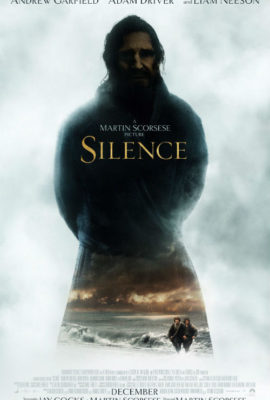Film Reviews

Silence
Genre: Drama
Director: Martin Scorsese
Cast: Andrew Garfield, Adam Driver, Liam Neeson, Tadanobu Asano, Ciaran Hinds, Issey Ogata
MPAA-Rating: R
Release Date: December 23rd, 2016
Despite being directed by Martin Scorcese (one of the most renowned directors of all time), the 2016 drama Silence never found the audience it deserved. The film offers a provocative statement about the nature of faith and resolve and even premiered at the Vatican. Adapted from the novel by Shûsaku Endô, the film tells the story of two young Christian priests in the 17th century who set out to prove that their mentor had not abandoned the faith.
Andrew Garfield and Adam Driver star as Father Rodrigues and Father Garupe, respectively. These men are disturbed when they hear that their mentor Father Ferreira (Liam Neeson) has abandoned the faith while on a dangerous mission trip in Japan. At the time, the Japanese government was torturing and even murdering Christians but Ferreira knew that when he left.
The two young priests argue that their mentor would never abandon his Christian faith even in the harshest of circumstances It’s only a rumor, they say, before volunteering to travel to Japan to find him.
Scorcese sets the tone in his opening scene as we watch Ferreira witness the persecution of his fellow Christians. They are tortured without hesitation by government officials with no hope in sight. The camera shows him in the midst of this turmoil and doesn’t come back to him for two more hours.
Because of that, audiences aren’t aware of Ferreira’s decisions (or mentality) for much of the film’s running time. Like the two main characters, viewers struggle with not knowing the truth. When the two priests arrive in Japan with the assistance of a tormented man named Kichijiro (Yôsuke Kubozuka), they are sidetracked when Christian believers– who keep their religious meetings hidden– approach them, asking for religious guidance and forgiveness. The two priests become integral to the small community.
They are eventually separated and both are imprisoned during their journey. They are then faced with painful decisions and their faith is tested. For much of this, Rodrigues is the primary protagonist. He struggles as he witnesses the brutality around him.
The film’s title refers to the idea that as his followers are tortured and brutalized for believing in him, God remains silent. It’s a painful concept to grasp and it’s one Rodrigues returns to again and again. “How can I explain his silence to all these people,” he asks. In a voice-over, he notes that God can hear the prayers of those who are prosecuted in his name but he wonders if he can also hear their terrifying screams?
There are no easy answers to these questions and director Scorcese seldom offers them. What he offers instead is an oftentimes hard-to-watch drama that explores Christian faith and the painful reality of religious prosecution (which sadly still occurs today). His camerawork is astonishing. He continually surprises with his visionary ability to capture moments of great pain. A sequence involving men being tortured while tied to crucifixes will be hard to forget.
As the story’s main hero, Garfield captures his character’s journey delicately. It’s hard to appreciate what the character undergoes here but the actor shows how his values change and evolve as he becomes a witness to the torment he’d only previously heard about.
When the film’s climactic sequence finally arrives, it’s hard not to appreciate all of the stakes involved and the faith that has been tested. When the credits roll, Scorcese has left the audience overwhelmed but also questioning their own religious limits.
Silence is undoubtedly a difficult film to watch but it’s one that raises real and profound questions about religion. For audiences willing to spend a few hours dealing with such a topic, this drama is a commendable and beautifully-filmed portrait of faith under fire.
John Hanlon is our film and television critic. He can be followed on Twitter @johnhanlon and on Facebook here.
Review by: John Hanlon












